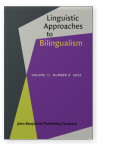Vol. 12:6 (2022) ► pp.715–747
Properties of child-directed speech in bilingual parents
A study on partial repetitions
How parents talk to young children matters to language and cognitive development. In the early years the quantity, quality, and diversity inherent in language from parents in the home predict differences in vocabulary knowledge, school readiness, and later academic achievement. However, most of what is known about child-directed speech (CDS) comes from studies of monolingual parents, and little is known about features of speech from bilingual parents. Here, we asked whether degree of bilingualism assessed within a single parent might be positively associated with CDS features that are known to facilitate children’s lexical and grammatical structures across languages – parental partial repetitions. During unscripted narrations (n = 91) of a picture book to their toddlers in English, mothers who reported being more bilingually balanced used a higher proportion of self-repetitions (both single words and 2-word combinations) within a brief time-frame. At the same time, more bilingual mothers preserved the same degree of lexical diversity as more monolingual mothers. The results obtained even accounting for differences in socio-economic status. These findings are discussed in terms of adaptive strategies that bilingual parents may consciously or unconsciously adopt in bilingual language development
Article outline
- 1.Introduction
- 1.1Parental self-repetitions as a cue to language discovery
- 1.2Does bilingualism moderate parental child-directed speech?
- 2.Method
- 2.1Participants
- 2.2Materials and procedure
- 2.3Parental bilingualism and language balance/dominance
- 2.4Measures of partial self-repetition
- 2.4.1Dependent variable: Repetitions in child-directed speech
- 2.4.2Dependent variable: Lexical diversity of repeated words in child-directed speech
- 2.4.3Beyond single-word repetitions
- 3.Results and analyses
- 3.1Pairwise correlation analyses
- 3.2Multiple regression analyses
- 3.2.1Results for repetitions
- 3.2.2Results for lexical diversity
- 4.General discussion
- 4.1Explaining the features of bilingual parental speech
- 4.2A new method to find patterns of repetitions in CDS
- 4.3Limitations
- 5.Conclusion
- Author contributions statement
-
References
